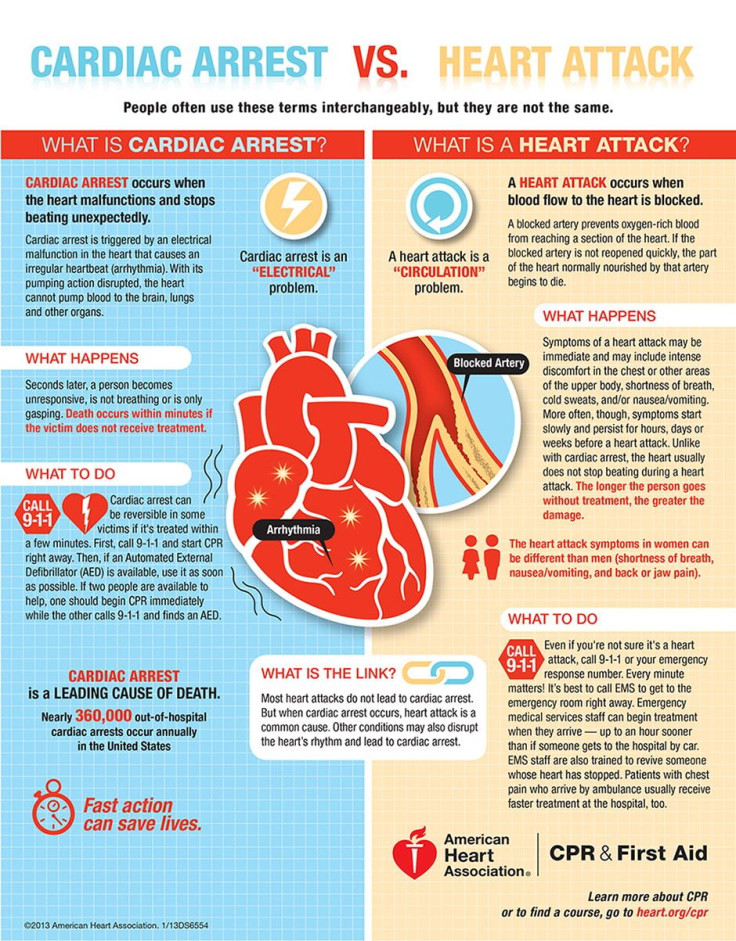Cardiac Arrest Or Heart Attack: Which Is The 'Big One'?

You’ve seen it countless times in the movies and for years it’s been a familiar plot device on TV — someone clutches his heart in agony and then falls to the floor unconscious. (“And … scene.”) Watching, your assumption is you’ve witnessed a heart attack… but is it the “big one,” as Fred Sanford used to say, or cardiac arrest?
Although people commonly use these medical terms interchangeably, in reality, a heart attack is distinct from cardiac arrest and while one can lead to the other — heart attacks are a common cause of cardiac arrest — it does not flow in reverse. Generally, when the heart itself suddenly stops beating — cardiac arrest — it is a much more swift and dangerous condition than a heart attack, which occurs when blood stops flowing to the heart and may show its effects only gradually. The key difference between the two is this: A heart attack is a circulation problem and cardiac arrest is an electrical problem, as this infographic from the American Heart Association makes clear.

Cardiac arrest
Sudden cardiac arrest usually occurs with no warning signs, so any symptoms are immediate, dramatic, and extreme:
- No pulse
- Breathing stops
- Sudden collapse
- Loss of consciousness
Nearly 360,000 instances of cardiac arrest occur annually, outside the hospital setting. In rare cases, a cardiac arrest is foreshadowed by fatigue, fainting, blackouts, dizziness, chest pain, shortness of breath, weakness, palpitations, or vomiting. Once cardiac arrest occurs, a person will die within a few minutes if they don’t receive prompt medical attention. Cardiac arrest may be reversible if treated within a few minutes. If you witness someone who has collapsed with a stopped heart, dial 9-1-1 and then administer CPR or use an automated external defibrillator, if one is available to you.
Heart Attack
Each year, nearly a million people in the U.S. have heart attacks, and many of them die. With immediate action and prompt attention, lives can be saved.
The symptoms of a heart attack vary from person to person, and this is part of what may be so confusing to a patient and a reason why many people do not recognize what is happening to them. One of the most common warning signs is shortness of breath, which could occur at rest or during physical activity. This may be a solo symptom, or it may occur before or along with chest pain or discomfort, another common warning sign. Most heart attacks involve discomfort — lasting more than a few minutes or recurring repeatedly — in the center or left side of the chest. This discomfort may mimic heartburn or indigestion or it can feel like pressure, squeezing, fullness, or acute pain. Another common symptom is upper body discomfort, including numbness, in one or both arms, the back, shoulders, neck, jaw, or upper part of the stomach.
Women are more likely than men to experience shortness of breath, nausea or vomiting, and back or jaw pain.
If any of these symptoms are ongoing, you need emergency medical attention in order to prevent sudden cardiac arrest. When the heart stops, brain damage can occur within four to six minutes. Call 9-1-1 before doing anything and you might ask emergency medical personnel if they recommend chewing a 162- or 325-milligram aspirin tablet, as it makes your blood less likely to clot. Remember: Aspirin may interact with other medications so you must be sure before you take it.



























